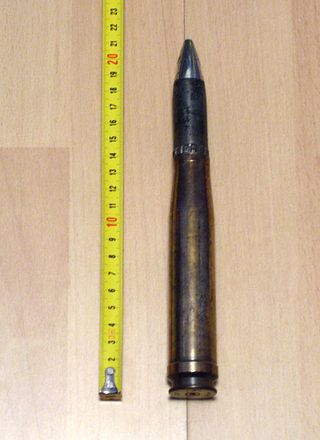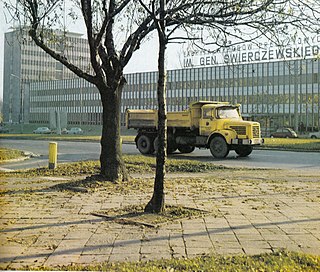
The charge at Krojanty, battle of Krojanty, the riding of Krojanty or skirmish of Krojanty was a Polish cavalry charge on the evening of 1 September 1939, the first day of the Second World War, near the Pomeranian village of Krojanty. It occurred at the start of the invasion of Poland and was part of the larger Battle of Tuchola Forest. Polish soldiers advanced east along the railway to a railroad crossroads 7 kilometres (4.3 mi) from the town of Chojnice, where elements of the Polish cavalry charged and dispersed a German infantry battalion. Machine gun fire from German armoured cars that appeared from a nearby forest forced the Poles to retreat. However, the attack delayed the German advance, allowing the Polish 1st Rifle Battalion and Czersk Operational Group to withdraw safely.

The TK (TK-3) and TKS were Polish tankettes developed during the 1930s and used in the Second World War.

The Bofors 37 mm anti-tank gun was an anti-tank gun designed by Swedish manufacturer Bofors in the early 1930s originally for Swedish use. It was exported to several countries during the 1930s of which several bought licences to produce it themselves. The gun was used in several conflicts but most of its fame comes from its use in the Spanish Civil War and the Winter War where it was used very successfully against light tanks and armored cars among other targets. Beyond its use as an infantry gun it was also used as the main armament in several armored cars and tanks such as the Dutch M39 Pantserwagen and the Polish 7TP to name a few. As the armor of tanks was increased during World War II the gun very quickly became obsolete as an anti-tank gun but was still used effectively as an infantry support gun for the entirety of the war, and well into the Cold War. This was due to its high fire rate, great mobility and effective high explosive shells.

The Model 35 antitank rifle was a Polish 7.9 mm anti-tank rifle used by the Polish Army during the 1939 invasion of Poland. It was designated model 35 for its design year, 1935: It was also known by its codename "Uruguay", after the country and by the name of its designer, Józef Maroszek.

Pistolet maszynowy wz. 39 Mors was a Polish submachine gun designed by Piotr Wilniewczyc and Jan Skrzypiński between 1936 and 1938. It was to have become the standard submachine gun of the Polish Army some time in the 1940s. However, its production was halted by the 1939 Invasion of Poland and World War II.

Ckm wz. 30 is a Polish-made clone of the American Browning M1917 heavy machine gun. Produced with various modifications such as greater caliber, longer barrel and adjustable sighting device, it was an improved although unlicensed copy of its predecessor, and was the standard machine gun of the Polish Army from 1931.
The Karabin samopowtarzalny wzór 38M, was a prototype Polish 7.92mm semi-automatic rifle used by the Polish Army during the Invasion of Poland of 1939.

The Carden Loyd tankettes were a series of British tankettes of the period between the World Wars, the most successful of which was the Mark VI, the only version built in significant numbers. It became a classic tankette design worldwide, was licence-built by several countries and became the basis of several designs produced in various countries.

The Lahti L-39 is a Finnish 20 mm anti-tank rifle used during the Second World War. It had excellent accuracy, penetration and range, but its size made transportation difficult. It was nicknamed "Norsupyssy", and as tanks developed armor too thick for the Lahti to penetrate, its uses switched to long range sniping, tank harassment and with the L-39/44 fully automatic variant, employment as an improvised anti-aircraft weapon.

Tanks were an important weapons system in World War II. Although tanks in the inter-war years were the subject of widespread research, few were made, in just a few countries. However, during World War II, most armies employed tanks, and thousands were built every month. Tank usage, doctrine, and production varied widely among the combatant nations. By war's end, a consensus was forming on tank doctrine and design.

The 20×138mmB or Long Solothurn cartridge is a type of ammunition used mainly for anti-aircraft and anti-tank weapons during World War II. The designation means the caliber is 20 mm, the length of the cartridge case is 138 mm and B indicates it is a belted case. The loaded cartridge weighs 300 grams (10.7 oz).

Państwowa Fabryka Karabinów was a Polish arms manufacturer active between the two World Wars. Founded in 1919 as the successor to the pre-World War I Gerlach i Pulst company, Fabryka Karabinów became part of the state-owned Państwowe Wytwórnie Uzbrojenia conglomerate in 1927. It was a sister company to Łucznik Arms Factory, the Munitions Factory of Skarżysko, and several others. By the end of the 1930s, Fabryka Karabinów was one of the largest arms producers of Poland. It was destroyed during World War II. Nationalized after the war and with a new focus on civilian precision tools, it was renamed as VIS after 1989, but liquidated in the early 21st century.

This article deals with the history and development of tanks of the Polish army from their first use after World War I, into the interwar period, during World War II, the Cold War and modern era.

C2P was a Polish light artillery tractor. Designed in the 1930s, it was the basic tractor of Polish anti-aircraft artillery during the 1939 Nazi and Soviet invasion of Poland. There are only two surviving vehicles, both in private hands in Poland.

4TP, otherwise known as PZInż 140, was a Polish light tank prototype. It was designed by 16 December 1936 by Edward Habich of the Państwowe Zakłady Inżynieryjne works. A light reconnaissance tank, it was to become a heavier replacement for TK-3 and TKS tankettes in Polish service. In addition to light, manoeuvrable chassis, the tank was to feature a turret with one 20 mm nkm wz. 38 FK autocannon and one Ckm wz. 30 machine gun.

Edmund Roman Orlik was a Polish architect, and World War II tank commander. During the Invasion of Poland by Nazi Germany in September 1939 he claimed to have destroyed ten German tanks, including one Panzer IV Ausf. B, the largest tank then fielded by Germany, with a 2.6 tonne TKS tankette armed with a 20mm autocannon.















